Dynamic transcription factor activity networks in response to independently altered mechanical and adhesive microenvironmental cues†
Abstract
Multiple aspects of the local extracellular environment profoundly affect cell phenotype and function. Physical and chemical cues in the environment trigger intracellular signaling cascades that ultimately activate transcription factors (TFs) – powerful regulators of the cell phenotype. TRACER (TRanscriptional Activity CEll aRrays) was employed for large-scale, dynamic quantification of TF activity in human fibroblasts cultured on hydrogels with a controlled elastic modulus and integrin ligand density. We identified three groups of TFs: responders to alterations in ligand density alone, substrate stiffness or both. Dynamic networks of regulatory TFs were constructed computationally and revealed distinct TF activity levels, directionality (i.e., activation or inhibition), and dynamics for adhesive and mechanical cues. Moreover, TRACER networks predicted conserved hubs of TF activity across multiple cell types, which are significantly altered in clinical fibrotic tissues. Our approach captures the distinct and overlapping effects of adhesive and mechanical stimuli, identifying conserved signaling mechanisms in normal and disease states.

- This article is part of the themed collection: RSC papers by NanoEngineering for Medicine and Biology 2018 Speakers


 Please wait while we load your content...
Please wait while we load your content...